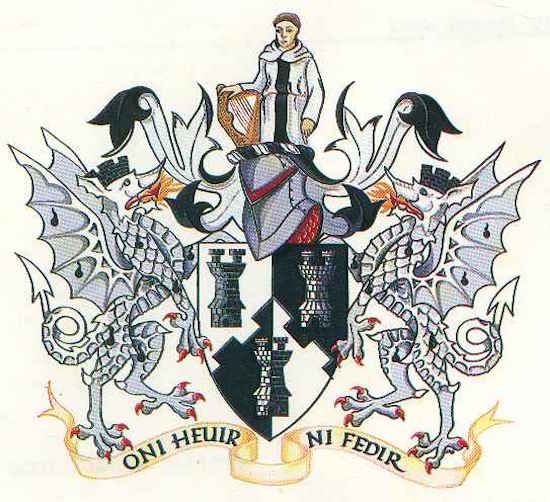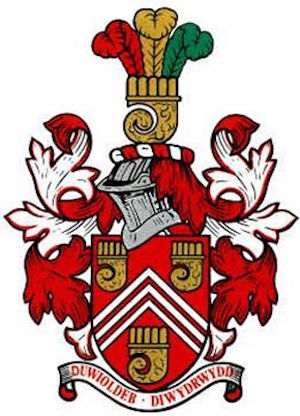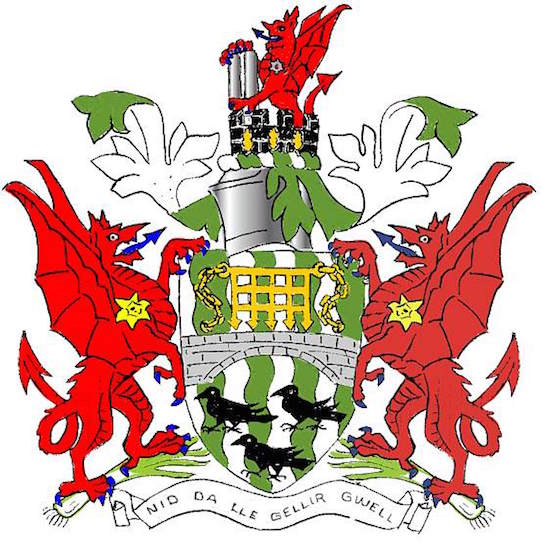Heraldry in the Borough
Neath

The arms were granted on February 11, 1983.
The design is based on the old seal of the Borough of Neath which had a distinctive double-turreted tower. The basic colours are black and white or silver. The black refers to the coal-mining and oil industries whilst the white or silver refers to the metal industries once so prevalent in the Borough.
The monk is a reference to the pre-Reformation Cistercian Abbey at Neath Abbey, whilst the harp refers to the strong musical tradition in the area. The dragon supporters are a reference to Wales and the flames refer to the old smelting industries of the Borough. The seven drops of oil on each dragon represent the oil industry once more and also the fourteen Communities which constitute the Borough. The Borough is entitled to have the dragons murally crowned. This charge is reserved for Boroughs and Senior Army Officers. The motto is derived from the former Rural District of Neath: ONI HEUIR NI FEDIR or, He who does not sow does not reap.
Port Talbot

Official blazon
Arms: Gules three Chevronels Argent between as many Clarions Or.
Crest: On a Wreath of the Colours issuant from a Clarion Or a Plume of three Ostrich Feathers Gules Gold and Vert.
Motto: 'DUWIOLDEB DIWYDRWYDD' - Godliness and industry
Origin/meaning
The arms were granted on April 19, 1976 to the Afan Borough Council, which was renamed to Port Talbot in 1986.
The arms are those of the former Port Talbot Borough.
Pontardawe

The arms were granted on February 10, 1976.
The shield has a background of eight alternate white and green waves running vertically, to suggest the topographical area with its green valleys and four principal rivers, the Lliw, the Loughor, the Clydach and the Tawe. Against this are set the gold portcullis and black ravens from the old seal of the Borough of Loughor.
The portcullis is the crest of the Dukes of Beaufort, former lords of the Borough, while the three ravens are considered to be derived from the arms attributed by the mediaeval heralds to Urien Rheged, a 6th century prince or local chieftain who built his residence at Loughor, and whose descendants, the Rhys family of Dynever, still bear the ravens in their arms.
Between the portcullis and the ravens, spanning the shield over the waves, is the bridge of Pontardawe, which was part of the insignia of Pontardawe RDC. Thus the shield expresses the union of Llwchwr and Pontardawe in the Lliw Valley District.
The crest symbolises the area's industries. At the base is a mural (walled) crown, a frequent emblem of local government, and a reminder of the ancient castle of LLwchwr. It is coloured black, to suggest the coal-mining areas and is charged with three ears of wheat for the agriculture of the rural district. From the crown rises the Welsh dragon, charged on the shoulder with a cogwheel for engineering, and holding a pair of mill rolls for the steel and tinplate industries.
County Borough of Neath Port Talbot
 As shown on HOME page
As shown on HOME page
Official blazon
Origin/meaning
The arms were granted in 1996.
The shield is divided per chevron three times as a reference to the three chevronels of the Clare family, Earls of Gloucester descended from Robert Earl of Gloucester (illegitimate son of Henry 1) who founded Neath and Margam Abbeys and whose family became Lords of the Manor of Glamorgan. Three chevronels are said to be the arms of Iestyn ap Gwrgan (living 1083-93) ruler of Glamorgan. The three chevronels occurred in the shield and badge of the former West Glamorgan, and the shield of the former Port Talbot, an the arms of the former Neath contain a hint of them in the division of the shield as per chevron. The colours green and white were the Tudor livery colours and have become the Welsh national colours. They occurred in the Arms of the former West Glamorgan and in those of the former Lliw Valley, where they represented hills and valleys.
The silver roundel charged with a black cogwheel uses the colours of the arms of the former Neath. The black relates to the coal, oil and manufacturing industries and the silver to metal industries.
Cogwheels featured in the crests of the former West Glamorgan and in the former Lliw Valley.
The demi Cistercian monk in the crest refers to the Cistercian Abbeys of Neath and Margam and it formed part of the crest of Neath. The monk emerges from a black mural crown as in the crest of the former Lliw Valley. The crown is also a reference to the black and white towers in the Arms of the former Neath. The monk holds a clarion, an emblem said to have been used as a punning Badge by the Clare family. Three clarions were used on early seals by the Abbeys of Margam and Neath. The origins of this heraldic emblem are obscure but it may possibly represent a portable organ and in modern times it has certainly been used as a symbol of music.
It represents not only the Clare family but the importance of music locally and throughout Wales. It appears prominently in the Arms and Crest of the former Port Talbot, but the musical allusion is made in the Neath Arms by a harp.
Two Welsh dragons serve appropriately as supporters. The dragon occurred in the former West Glamorgan Crest and in the supporters of the former Neath and former Lliw Valley Crests. They hold cords of the livery colours from which are suspended the two hybrid emblems from the Arms of the former West Glamorgan namely a green pine cone (for forestry and the countryside) dimidiating a Goutte Sable, or black droplet (for oil refining and connected industries). The dragons wear mural crowns round their necks as a reference to their civic nature. They stand on a grassy compartment set with Welsh daffodils and stylised waves of white and green as in the arms and badge of the former Lliw Valley and part of the former West Glamorgan compartment (where they are white and blue).
The motto at the base of the Arms is in the Welsh language, and reads LLWYDDO DRWY YMDRECH. This, translated into English is SUCCEEDING THROUGH ENDEAVOUR.

